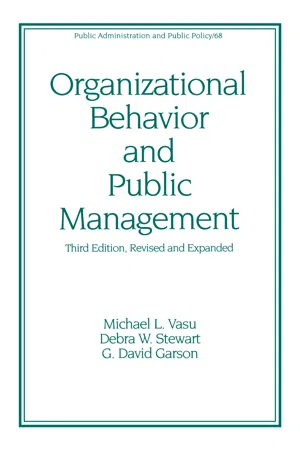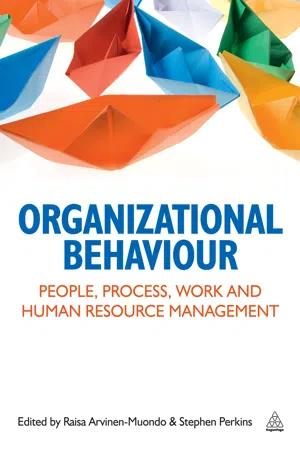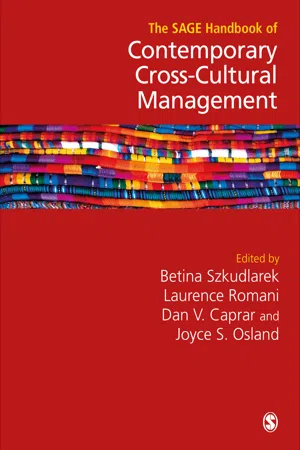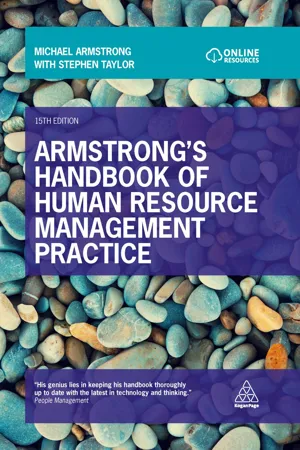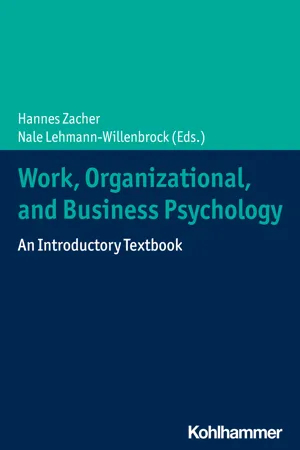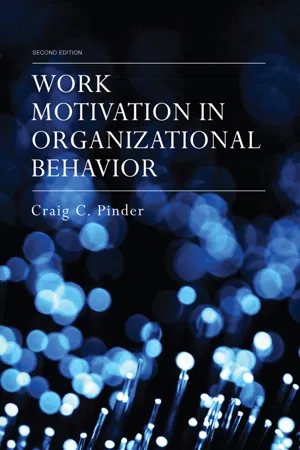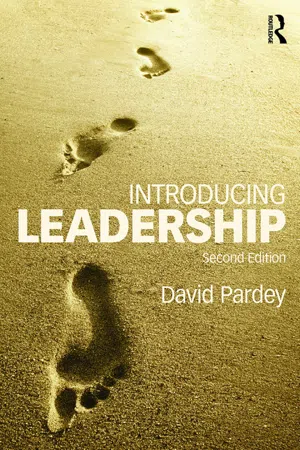Business
Motivation in the Workplace
Motivation in the workplace refers to the factors that drive employees to perform their best. It encompasses both intrinsic and extrinsic motivators, such as recognition, opportunities for growth, and fair compensation. Understanding and effectively addressing employees' motivational needs can lead to increased productivity, job satisfaction, and overall success for the organization.
Written by Perlego with AI-assistance
Related key terms
Related key terms
1 of 4
Related key terms
1 of 3
12 Key excerpts on "Motivation in the Workplace"
- eBook - ePub
- Lazenby JAA(Author)
- 2020(Publication Date)
- Van Schaik Publishers(Publisher)
Employees want to see what is in it for them so that they can put in more effort and work together as a team. He stressed the importance of communication and honesty with employees. Employees do want to hear what they are doing well and where they can improve. Employees must understand that they are only as good as their performance is for the moment, and not forever.He also highlighted the importance of a value system in the organisation and specifically mentioned trust to help the organisation in the search for innovation. Communication in an organisation is crucial and it will allow an organisational culture that is open to change and learning.Source: Adapted from http://www.leader.co.za/article.aspx?s=6&f=1&a=529 (accessed on 11 March 2015)An important part of motivating employees is to be a motivated manager, because enthusiasm is contagious. If employees see that their managers are enthusiastic about their job, they are more likely to be enthusiastic about their own job. This chapter will present several theories of Motivation in the Workplace and provide specific approaches to motivating employees.Passage contains an image
11.2 WHAT IS MOTIVATION?
Motivation means “to move” and is derived from the Latin word movere. It is that state of an individual’s point of view which represents the strength of his or her tendency to apply some particular behaviour. Motivation is thus an internal vigour which stimulates, regulates and upholds a person’s actions and determines whether and how he or she will behave. Motivation is the inner drive that directs a person’s behaviour towards the achievement of goals. Motivation can therefore be defined as a process which initiates, directs and sustains human behaviour. It refers to a person’s desire to do the best possible job or to 249 put forth the maximum effort to perform the assigned tasks. It is clear from this definition that motivation is directed at behaviour towards goal achievement.People often think that a “happy” employee is also a “motivated” employee. However, although there may be a relationship, motivation is the level of desire employees feel to perform, regardless of their level of happiness. Motivated employees will be more productive and more engaged and will feel more invested in their work. This will then lead to a “happy” employee. When employees experience these things, it helps them and the organisation to be more successful. Read Management in action 11.2 - eBook - ePub
The Psychology of Behaviour at Work
The Individual in the Organization
- Adrian Furnham(Author)
- 2012(Publication Date)
- Psychology Press(Publisher)
6 Work motivation and satisfactionIntroductionOne of the oldest, and most difficult, topics in psychology is the fundamental problem of why people are motivated to do anything at all, and if they do something, why that and not something else. Managers and researchers talk of goals, incentives, needs, reinforcers and rewards, and it is clear that there are many definitional problems. The question is why people choose, or not to choose, to do something, how much effort they put into it, and how persistent they are in trying to achieve it. The issue is really twofold: the nature of the driving force (where it comes from; what are its properties) and the direction and maintenance of the drive (what effects does it have on individual behaviour). As Greenberg and Baron (2003) note, motivation and job performance are not synonymous; motivation is multi-faceted, people are motivated by more than just money. These problems have intrigued and fascinated psychologists and managers of all persuasions for a very long time. Indeed, there are so many approaches and theories in this area that most reviewers have attempted to classify or taxonomize them into groups, such as need reduction theories, expectancy value theories and mastery/growth theories.Motivation is a hypothetical construct which refers to a set of multiple internal processes with multiple consequential behaviours. It is goal directed. Motivational processes result from certain things about the individual: ability (job knowledge), dispositions (stable traits), beliefs and values, and affective mood state. These are also related to an individual’s skills. However, motivation is also closely related to job context: the nature of the task/job, the physical environment, implicit and explicit rewards (reinforcements), social norms and the wider corporate culture. These factors also relate to how easy or hard it is to do the job. Thus individual factors and job context together determine motivational processes that affect a person’s effort, persistence, attention and task strategy. Thus motivational processes lead to intentions that result in behaviour, but these are highly dynamic and change over time (Mitchell & Daniels, 2003). - Michael L. Vasu, Debra W. Stewart, G. David Garson, Michael L. Vasu, Debra W. Stewart, G. David Garson(Authors)
- 2017(Publication Date)
- Routledge(Publisher)
3Motivation in OrganizationsIntroduction
Every organization needs motivated people! Why? Because all organizations seek to be effective, to get the job done. They also seek to be efficient, that is to maximize the outputs per unit of input. Efficiency is typically calibrated in terms of an organization’s productivity. To be both efficient and effective public managers must work with and through people. In the most generic sense, an organization is a group of people working toward a common goal. Both experience and common sense indicate that all people do not expend equal effort toward the realization of organizational goals. When they do not motivation problems are reflected in such factors as low productivity, absenteeism, and rapid employee turnover.As an academic area of study, human motivation is the subject of textbooks itself and has a variety of dimensions (McClelland, 1988; Beck, 1990; Steers and Porter, 1991). The important focus, from a management perspective, is on motivation and its relation to work behavior (Quick, 1985; Carlisle and Murphy, 1986; Mook, 1987; Wright, 1992; Robertson and Tang, 1995, Behn, 1995). They are typically concerned with what causes or drives behavior and how to direct and sustain that behavior toward specific organizational goals (Wright, 1992). However, managers need to understand that motivation takes place within a contextual framework. This contextual framework adds more variables to questions of organizational performance than motivation alone.Motivation in Context
The cause of differences in the effort expended by individuals at work is the result of a number of factors. One of these factors is related to different levels of ability among employees. Differences in ability arise from the simple fact that there are significant individual differences that affect work performance. A given individual, for example, may be in the 90th percentile in math ability, 20th percentile in spatial ability, 75th percentile in resistance to fatigue, and 99th percentile on written ability, etc. However, ability itself is only part of the equation. Clearly, whatever the ability level of individuals, the effort- eBook - ePub
Organizational Behaviour
People, Process, Work and Human Resource Management
- Stephen J Perkins, Raisa Arvinen-Muondo(Authors)
- 2013(Publication Date)
- Kogan Page(Publisher)
This chapter attempts to explore some of these issues and explain some of the variation in how motivation may be perceived with the help of a series of classical and contemporary motivation theories and models. This chapter aims to provide insight into the roots of some taken-for-granted ‘classics’ informed by economics and psychology, placing these into their institutional context, as well as assessing the continuing controversy in debates surrounding the extrinsic/intrinsic motivation dichotomy. Therefore, in the first section I provide an overview of motivation and motivation theories, followed by a multidisciplinary analysis of motivation literature to update and balance longstanding motivation commentary and its relationship with employee engagement. Such multidisciplinary analysis is intended to reframe enquiry into employee motivation in organizational settings reflecting the role of social justice, perceptions of fairness and mutual obligation of social exchanges under the psychological contract label. Finally, I will discuss the role of managers and employers in developing HRM systems to enhance employee motivation and engagement, job commitment and organizational commitment. A key aspect is the influence of ‘leader–member exchange’ and ‘organizational support’ highlighting the vital role of line managers in leading and guiding employees individually and in teamwork, creating environments with the aim of motivating sustainable high performance outcomes.Employee motivationMotivation generally refers to the willingness to exert a high level of effort to reach any goals or to satisfy any individual need. Daft and Marcic explain that motivation refers to ‘the forces either within or external to a person that arouse enthusiasm and persistence to pursue a certain course of action’ (2004). Motivation at the workplace or employee motivation refers to the willingness to exert a high level of effort to reach organizational goals, conditioned by the effort’s ability to satisfy some individual need (Robbins, 2005). Simply put, unmotivated employees are likely to expend little effort in their jobs, have poor attendance and time-keeping records, resist change, produce low quality work and exit the organization if given the opportunity. The counter logic is then that employees who feel motivated towards their work are more likely to be consistent, creative, enthusiastic and productive, turning out high quality work that they willingly undertake. Besides the work content and process-related factors, other contextual factors such as family, society and culture can influence the motivation level of employees. The importance of differences in employee motivation and individual needs warrants consideration. Furthermore, priorities in individual needs are likely to change over time. Consequently, in order to manage a workforce made up of employees with individual and changing needs, HR practitioners together with middle and senior managers would benefit from understanding existing motivational models and the theories behind them. Understanding of the fundamentals can enhance their ability to identify appropriate HR systems that can be matched with employee needs. - eBook - ePub
- Richard Pettinger(Author)
- 2020(Publication Date)
- Routledge(Publisher)
Chapter 4 Motivation and rewards Motivation is a reflection of the reasons why people do things. All behaviour has purposes. All behaviour is therefore based on choice: people choose to do the things they do. Sometimes this choice is very restricted (sink or swim for example). Sometimes it is constrained by the law (for example, stopping the car when the traffic lights are red). And again, it is constrained by the norms and processes of society: for example, people tend to wear smart clothes to a party where they know that everybody else will be well dressed. In each case however, there is a choice, though the propensity, encouragement and direction to choose one course of action rather than another in the examples given is strong, if not overwhelming. The ability to gain the commitment and motivation of staff in organizations has been recognized as important in certain sectors of the business sphere. It is now more universally accepted as a critical business and organizational activity, and one that has highly profitable returns and implications for the extent of the returns on investment made in the human resource. There is a direct correlation between going to a lot of trouble to motivate staff and profitable business performance. In the first place, the ability to motivate staff in the workplace stems from understanding the following: A general appreciation of how human beings behave in particular situations, and in response to their needs to satisfy and fulfil basic drives, instincts, needs and wants. Some of these are instinctive, others are the product of the civilization in which they live, and the socialization processes contained therein. Others still are the product of the occupation held by the individual and the education, training, ethics, standards and aspirations thus instilled - Betina Szkudlarek, Laurence Romani, Dan V. Caprar, Joyce S. Osland, Betina Szkudlarek, Laurence Romani, Dan V. Caprar, Joyce S. Osland(Authors)
- 2020(Publication Date)
- SAGE Publications Ltd(Publisher)
20 Culture, Context, and Work Motivation Carlos J. Sanchez-Runde and Richard M. SteersWhy do people work? Habit, drive, need, expectations, social pressure, or a combination of these and other factors in social systems? This question is at the heart of studies of human behavior and has captured the attention of social scientists for well over a century. Numerous theories have been advanced, explored, and argued about cause and effect, as well as about the implications of work motivation for job attitudes, performance, and psychological well-being. However, when this topic is considered within a cross-cultural framework, an entirely new issue emerges: that is, are the drivers of work motivation universalistic or particularistic? Do they vary within or across cultures in systematic ways that create unique environments or contexts that influence how and why people work? And if so, how is this accomplished?The topic of work motivation has a long history of both empirical research and theoretical development (Mitchell and Daniels, 2002; Kanfer, Chen, and Pritchard, 2008; Pinder, 2008; Latham, 2012). Its application to cross-cultural management is a more recent phenomenon, but still there have been some substantive contributions over time, including theoretical developments (e.g., Hofstede, 2001; House, Hanges, Javidan, Dorfman, and Gupta, 2004) and systematic research reviews (e.g., Gelfand, Erez, and Aycan, 2007; Erez, 2008; Sanchez-Runde, Lee, and Steers, 2009; Ronen and Shenkar, 2017). Two empirical review articles (Bhagat and McQuaid, 1982; Markus and Kitayama, 1991) are particularly noteworthy because they were published early in the development of the field and, if citations are any measure, have had a significant influence on theory development. Moreover, an exemplary example of taking motivation theory – and organizational behavior in general – beyond Western boundaries can be found in the Handbook of Chinese Organizational Behavior- Michael Armstrong, Stephen Taylor(Authors)
- 2020(Publication Date)
- Kogan Page(Publisher)
The earliest approaches to understanding human motivation date from the time of the Greek philosophers and focused on the concept of hedonism as a principle driving force in behaviour. Individuals were seen as directing their efforts to seeking pleasure and avoiding pain. This principle was later refined and further developed in the works of philosophers such as John Locke and Jeremy Bentham in the 17th and 18th centuries. Motivation theory as we know it today started in the earlier part of the 20th century with the contributions of the exponents of scientific management (instrumentality theory). In the middle years of that century the behavioural scientists entered the field and began to develop the ‘content’ or ‘needs’ theory of motivation. The main process theories such as expectancy theory emerged in the 1960s and ’70s.The aims of this chapter are to explore the meaning of motivation, define the two main types of motivation – intrinsic and extrinsic – describe the three main theories of motivation – instrumentality, content and process – and outline approaches to motivation strategy.The meaning of motivation
The term ‘motivation’ derives from the Latin word for movement (movere). A motive is a reason for doing something. Motivation is the strength and direction of behaviour and the factors that influence people to behave in certain ways. People are motivated when they expect that a course of action is likely to lead to the attainment of a goal and a valued reward – one that satisfies their needs and wants. The term ‘motivation’ can refer variously to the goals that individuals have, the ways in which individuals choose their goals and the ways in which others try to change their behaviour. Locke and Latham (2004: 388) observed that: ‘The concept of motivation refers to internal factors that impel action and to external factors that can act as inducements to action.’As described by Arnold et al (1991) the three components of motivation are:- Direction – what a person is trying to do.
- Effort – how hard a person is trying.
- Persistence – how long a person keeps on trying.
Well-motivated people engage in positive discretionary behaviour – they decide to make an effort. Such people may be self-motivated, and as long as it means they are going in the right direction to attain what they are there to achieve, this is the best form of motivation. But additional motivation provided by the work itself, the quality of leadership, and various forms of recognition and reward build on self-motivation and help people to make the best use of their abilities and to perform well. There are two types of motivation, as described below.- eBook - ePub
- Christine Hodson(Author)
- 2014(Publication Date)
- Routledge(Publisher)
3 Motivation at workIntroduction The behaviourist model of motivation Maslow’s hierarchy of needs McClelland: the need for achievement Job satisfaction SummaryIntroductionOne of the main concerns of organisational psychology is to discover the motivation for working. Perhaps we should start by defining motivation. A motivator is something which induces a person to act. Motivation can therefore be described as purposive behaviour directed towards achieving a goal. The goal may be physiological, for example, a thirsty individual will be motivated to find something to drink and their behaviour will be directed to that end. However other goals may be much more complex. In the early days of psychology attempts were made to list the basic human needs that motivate human behaviour. The lists became so long that the attempt was quietly abandoned!In the previous chapter we examined Warr’s view of what work has to offer the individual but the questions of why we choose to work at all, where we choose to work, and how much effort we expend whilst there, still need answering.The behaviourist model of motivationBehavioural theory is based on the theories of operant and classical conditioning and is extended to social learning theory. It suggests that our behaviour is governed, or shaped, by the responses we meet in our environments. We will repeat behaviours which we find pleasant and which meet our needs, we will stop behaviours which produce no response and we will actually avoid unpleasant activities. This theory was highly influential in the early development of organisational psychology, particularly as it was taken up by Taylor (1911).Conditioning theoryClassical conditioningClassical conditioning involves learning by association. If event A is consistently followed by event B then they will become associated. Event A will cause people and animals to anticipate event B. If you have a dog or cat and feed it on tinned food you will have observed that opening any tin produces a response from your pet. Your cat may wrap itself round your legs in an affectionate manner and your dog is likely to become excited. They have learned that open tins are often followed by food in their bowls. - eBook - ePub
Work, Organizational, and Business Psychology
An Introductory Textbook
- Hannes Zacher, Nale Lehmann-Willenbrock, Hannes Zacher, Nale Lehmann-Willenbrock(Authors)
- 2022(Publication Date)
- Kohlhammer Verlag(Publisher)
Self-determination theory as applied to the work setting is not without criticism, especially when it comes to the ongoing controversies regarding the effects of rewards and incentives on employee motivation. Specifically, it is argued that work is often not fully self-determined or integrated and over-justification effects are not valid in work settings (Gerhart & Fang, 2015). Work in the context of paid employment usually involves externally assigned and not self-developed tasks and extrinsic rewards (e.g., salary, promotions, power) are relevant. Deci et al. (2017) conclude that the positive or negative effects of rewards on internal motivation depend on different conditions, such as the type of rewards (e.g., positive verbal feedback versus tangible rewards), the contingency of rewards, and the context in which rewards are given (e.g., controlling or autonomy-supportive context). Intrinsic motivation may also have negative side effects. For example, Shin and Grant (2019) found that working on tasks that were intrinsically motivating might decrease performance in subsequent tasks that were less interesting, whereas moderate intrinsic motivation in one task was associated with better performance in the following tasks.Context Theories of Work Motivation
A broad variety of distal and proximal context factors can influence individuals’ work motivation. Culture, economic conditions, and organizational climate are examples for distal context factors. Culture provides humans with a shared perspective on how they perceive and respond to the world (Hofstede, 2001; Morling & Kitayama, 2008). It shapes what people perceive as desired or appropriate, which, in turn, influences the goals people adopt (Diefendorff & Chandler, 2011). National culture is assumed to influence motivation through several mechanisms, including (a) personal characteristics (e.g., self-concept, needs), (b) work norms and values, and (c) societal factors (e.g., educational system, politics) (Steers & Sánchez-Runde, 2017). Organizational culture pertains to fundamental beliefs and norms, core assumptions, and expectations shared by organizational members (O’Reilly et al., 1991). Research shows that the perception that one has a good fit with the organizational culture (person-culture fit) can lead to greater motivation and performance (O’Reilly et al., 1991). Organizational climate - eBook - ePub
Performance Management
Theory and Practice
- Susan Hutchinson(Author)
- 2013(Publication Date)
- CIPD - Kogan Page(Publisher)
Theories on work motivation are premised on the assumption of workers as individual actors. It can be argued that group motivation to work is informed by individual motivation to do work. So if a person finds a job boring and demotivating, his/her perspective of that job will not change because he/she must now perform it with others. However, it could be argued that team members motivate and demotivate each other. Theory on collective efficacy (Bandura, 1986), which is based on the shared belief of team members that their team’s capacity to perform is important, is relevant here. Theory on team social identity also provides useful insights into the motivation of teams. In a sports team setting, for example, in-group identity can be a powerful motivator for improving performance, particularly under strongly competitive conditions.1 Do needs change because people work in groups?2 What additional factors might influence motivation in a group setting at work?Before answering these questions you may like to read the article by Theodore Lewis (2011) which critically examines the merits of two theories – social identity, and collective efficacy – as bases of group work motivation.CONCLUSION
Motivation is a necessary contributor to performance (but not the only contributor) and managers have to understand why a person behaves in a certain way and the factors that may influence action. The problem, however, is that motivation is an invisible process and very individual in nature – what motivates one person may leave another completely unmotivated.This chapter has considered some of the key theories on motivation and their relevance for performance management practice. Although there is no one universally accepted theory on motivation, there are an enormous number of established studies. All offer different perspectives and insights, and despite their shortcomings (and age) they remain highly influential. The chapter has considered what are called content theories, which try to explain the ‘what’ of motivation by focusing on needs that shape motivational action. Although each theory has its own view on which needs are most important, they can best be viewed as complementary. For example, Maslow and Alderfer’s theories are closely related in viewing a hierarchical ordering of needs. Herzberg’s hygiene factors are similar to Maslow’s psychological, safety and affiliation needs, and Alderfer’s existence and relatedness needs. Herzberg’s motivators are broadly comparable with Maslow’s higher-order needs, with growth in Alderfer’s model, and power and achievement in McClelland’s theory. One of the most important contributions these models make is to distinguish between extrinsic and intrinsic motivators. They also highlight the influence of the nature of the job and the importance of job design. However, these theories also share some shortcomings. They mostly adopt a universal perspective and assume that people have a common set of needs, ignoring individual differences and the impact of contextual factors such as national and organisational culture. - eBook - ePub
- Craig C. Pinder(Author)
- 2014(Publication Date)
- Psychology Press(Publisher)
Persistence is a major element of work motivation. Our definition accommodates three of the five “behavior patterns” identified by Maehr and Braskamp (1986) and Maehr (1987) : Choice (as it relates to absenteeism behavior); persistence (length of service); and continuing motivation (voluntarily upgrading one’s work skills). 6 Likewise, the definition takes into account work behaviors described by various authors – “willingness to cooperate,” “innovative and spontaneous behavior,” “prosocial behavior,” and, most recently, “personal initiative” (Frese, Kring, Soose, & Zempel, 1996) – all of which imply working in a way that goes above and beyond the call of duty (see Dalal, 2005 ; LePine, Erez, & Johnson, 2002). 6 The definition does not, however, fit with two of their categories, “activity level” and “performance,” because they are related to performance, not motivation, per se. This is a major distinction that will be discussed at length later in this chapter. Another feature of the definition is that it does not imply that motivation is the sole source of human behavior, or that work motivation is the sole source of work behavior, per se. Rather, it readily accommodates the fact that forces other than motivation also contribute to human action, whether on the job or off. This matter is critical in view of a recent, highly critical attack by Ford (1992) on traditional theories of motivation. Among other claims, Ford (p. 10) has argued that, in order to be of value, the concept of motivation must be limited to account only for the “psychological processes in the direction, energization and regulation of behavior pattern.” While Ford sees motivation as strictly psychological and separate from other forces such as biology, environmental and “non-motivational psychological and behavioral influences,” our definition admits the role of many biological factors in energizing and controlling behavior - eBook - ePub
- David Pardey(Author)
- 2016(Publication Date)
- Routledge(Publisher)
This chapter has explored some of the more widely known models of motivation and looked at how they relate to each other. Instead of trying to contrast them and highlight the differences, it has sought to find the similarities and has used this to identify the strategies that you can use to encourage people to perform to their full potential. In particular:■ Encourage people to utilise their knowledge and skills (competence) to the full, providing (and inviting) feedback to help develop and enhance their performance.■ Involve people in decision-making and seek their advice, to enhance their sense of control over their own work and their self-esteem.■ Encourage people to aim to achieve what they want to achieve, so that they feel a sense of fulfilment and commitment to their agreed goals.Questions
■ What really motivates you at work? Think about the things that really matter to you; money, power, the satisfaction you get from the job, the relationships you enjoy with others at work, or what? To what extent are these factors intrinsic and to what extent are they extrinsic?■ What does your employer do to enhance this sense of being motivated, and what is done that has a negative impact?■ How well motivated are the people you (aspire to) lead? How well do they respond to the policies and systems that the organisation has established to motivate them? How well do they respond to your own behaviour?■
Index pages curate the most relevant extracts from our library of academic textbooks. They’ve been created using an in-house natural language model (NLM), each adding context and meaning to key research topics.
Explore more topic indexes
Explore more topic indexes
1 of 6
Explore more topic indexes
1 of 4


